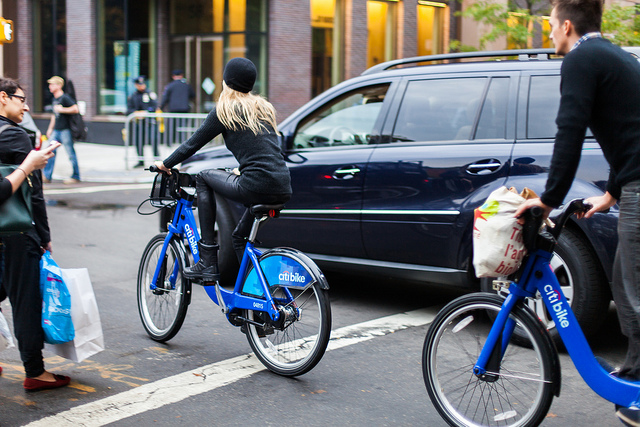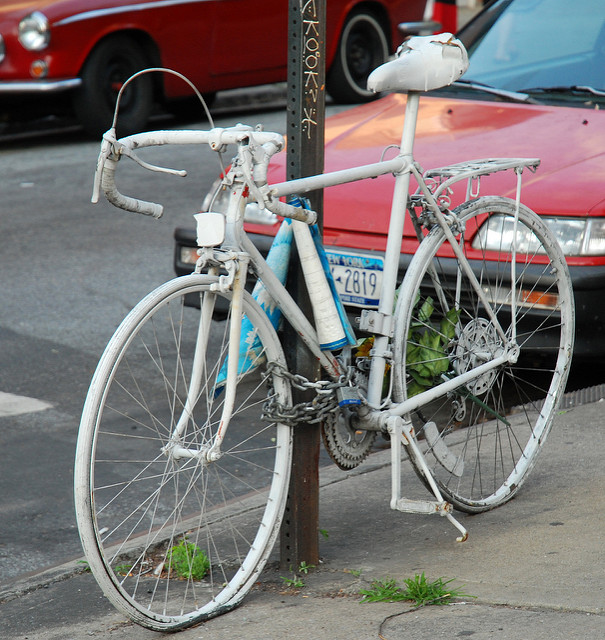People Are Pointing out the Problem With This Tweet From the LAPD
By:
We all know bicycles are good for our cities. They cut down on traffic, reduce carbon emissions, and they can make you healthier. Plus they're just plain fun. Nothing beats the wind in your hair, watching the world slide backwards beneath your wheels.
 Billie Grace Ward - flickr.com
Billie Grace Ward - flickr.com
But bicycles can be dangerous, too.
Particularly in dense urban environments with lots of cars. According to the CDC, "In 2013 in the U.S., over 900 bicyclists were killed and there were an estimated 494,000 emergency department visits due to bicycle-related injuries." Why is biking so dangerous? You could do some high school physics to figure it out—momentum equals mass times velocity—but most of us know the answer intuitively: when a bike hits a car, the car wins. Every time.
One cyclist was killed and injured just this Wednesday in Los Angeles.
In an apparent hit-and-run in Winnetka—an LA neighborhood just north of Topanga State Park—two cyclists were hit by a driver, who then sped away. The most chilling aspect of the story, though, was that—according to the one and only witness—the crash appeared to be intentional on the part of the driver. Police are still trying to determine exactly what happened, but if the driver did intentionally hit the cyclists, that would constitute homicide.
 cisc1970 - flickr.com
cisc1970 - flickr.com
But the LAPD's response didn't focus of the negligence—or malice—of the driver at all.
Instead of reminding drivers to watch for cyclists, follow the speed limit, or not drive away when they hit someone, the LAPD took the opportunity to remind cyclists to wear helmets and use bike lights.
People were not happy.
If these cyclists were murdered, then bike lights probably wouldn't have done them much good. Many rushed to point this out.
Citing the obvious victim-blaming in the tweet, users responded—both seriously and sardonically—to the LAPD's assertion that it's a cyclist's duty to avoid being intentionally run over.
What's more, video from ABC7 LA shows footage of the mangled bikes—with lights still flashing.
It seems a lack of light wasn't the issue at all, but the instinct was to blame the cyclists, regardless of the facts.
While the LAPD did not delete the original tweet, the department did add some context.
Hours later, the LAPD tweeted this, reminding drivers to stay aware:
And this, soliciting help in solving hit-and-run crimes:
Asked for comment, an LAPD spokesperson told ATTN:
"We can certainly understand why cyclists would feel that the tweet was blaming the victims, instead of the driver. When it comes to cycling safety, we would hope that everyone uses the safety equipment available to them—and that includes drivers being aware of crosswalks and bike lanes."
The rush to blame cyclists highlights a big problem in the United States.
While countries like Denmark and the Netherlands have made great strides in helping drivers and cyclists co-exist on busy city streets, the United States has not had the same success. But if bikes are a way to help save the planet, reduce traffic, and give able-bodied people some much-needed exercise, it's imperative that we make biking less deadly.
That will never happen if we place the blame for crashes on cyclists alone. In the United States, it's exceedingly rare for drivers to get cited for reckless driving. Take New York, for example, a city that has shown a huge commitment to building bike infrastructure over the last decade. According to NextCity, "there were 14,327 pedestrian and cyclist injuries in 2012 as a result of vehicle crashes, but police cited only 101 motorists with careless driving, a rate of less than 1 percent." Indeed, the NYPD often responds to cycling fatalities by ticketing cyclists.
Wearing helmets and using bike lights is all well and good, but drivers need to look for cyclists. As cycling becomes more and more popular in the United States, this will only become more apparent. After all, drivers—not cyclists—are the ones driving inside a 2,500 pound box—and with that power comes a lot of responsibility.
